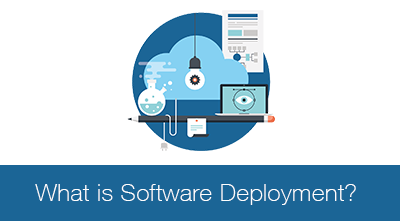What is Software Deployment?
Software deployment is the procedure of making software ready for launch.

Introduction:
Software deployment is the process of delivering completed software to the client who ordered it or rolling out the software to consumers. Software deployment should only take place after thorough testing to ensure that all the flaws and bugs have been identified and fixed.
Understanding Software Deployment
It is usually a planned initiative that consists of different steps or stages that occur in the production of operational software.
For instance, in the world of web development, deployment does not mean being released to the public. Rather, it means moving the software to a server where it is placed into action. This can be done prior to final testing before a release to the public or the client for whom the software is being developed.
In short, deployment varies significantly from one case to another. In a more generic sense, it basically means to get your software ready for actual use. A great deal will depend on your development chain/life cycle, and where the software is at during that cycle.
As an example, you might deploy code to a test server for further testing and evaluation prior to being deployed for use by the customer or by the general public. In this instance, the code will not be available to anyone but the development team, but it is still considered “deployed”.
In its strictest sense, software deployment refers to the release of the final version of the software or an app to either a customer or the general public. This takes place at the end of the life cycle, but prior to the start of maintenance.
Interestingly, there are other terms that are sometimes used interchangeably with deployment, although not always. One of these is implementation, although this is generally reserved for software that will be used strictly on a client’s or customer’s server and must be installed, configured, tested and adapted. Another word that is sometimes used in the same context is released. In this sense, the word is used as a verb, as in “to release”, rather than in the sense that there is a particular software version being discussed.
Advantages of Software Deployment
- Expedites the business processes with custom made software solutions by intensifying in-house operations and potency of the organization.
- Deploying a tailor-made software can automate the methods involved in business and create centralized management.
- Going by the modern mobile trend, applications that help businesses connect to devices from remote while the users can operate from any device at any time.
Some of the Best Software Deployment Practices are as follows -
- Implement a Deployment Checklist
Set up a process while you deploy new software. A checklist helps you to comprehend what must be done next so that you will not miss out on any of the crucial steps of the deployment process.
- Choose the Right Deployment Method
Somewhere between comfort and total cost of ownership is the correct deployment method. Once you have discovered that ratio, the deployment method should be apparent.
- Automate your Deployment Method
Deployment of the latest software versions manually is a tedious task that might result in multiple human errors. Automating the deployment process, lessens the possibilities of mistakes, increases the deployment pace and streamlines the process.
- Adopt Continuous Delivery
Using Continuous Delivery ensures to facilitate the code for the required deployment. This is done by executing the application in a proto-type environment to assure if the application is proper to function and meet the needs once deployed.
- Use a Continuous Integration Server
Continuous Server Integration is important for any successful agile deployment. This guarantees that the finished program works on a developer’s machine.
- Useful Software Deployment Tools to Streamline Software Delivery:
Software deployment tools make the method of distributing software and updates as simple as possible. Usually, these tasks are automatic or programmed to facilitate software developers to concentrate on what they do best – writing code. And the best tools go with a variety of platforms and prototypes of infrastructures, making it accessible to streamline the workflow in your preferred setting.
Software deployment tools also enable developers to track progress on their projects, and manage changes. Constant integration and deployment may be utilized to deploy software as changes are done, giving seamless updates for end-users.
Choosing the best software deployment tool is difficult because what might be best for a particular development team may not meet another team’s requirements.
The following are some of the leading software deployment tools available in the market-
- Bamboo
- TeamCity
- AWS CodeDeploy
- Octopus Deploy
What Comes after Deployment?
Deployment is not the last stage of the software development life cycle. The reason for this is that there is simply no way to catch all bugs and flaws during testing. Maintenance is the final step of the life cycle, and this is when remaining fixes will be delivered. It is also when additional features or functions might be introduced, and updates to the software made.